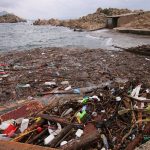Worrying ecological trends in the Adratic Sea.
In the stomachs of red mullets, sea bream and sardines, commercially important fish that live in the Adriatic Sea, pieces of microplastics have been found. That is the result of research conducted as part of the DeFishGear project which involved seven countries of the Adriatic-Ionian region (Slovenia, Italy, Croatia, Bosnia and Herzegovina, Montenegro, Greece, Albania), reports pomorac.net on September 4, 2016.
Cans, plastics, bottles, discarded tires, medical waste, cigarette butts… All this and much more could be seen this and previous summers on the beaches across the Adriatic and on the seabed. Beaches are full of tourists, and while those located in towns are cleaned, as soon as you move a little bit away the situation changes completely.
“DeFishGear project dealt with the problem of marine garbage. Until now, we did not have enough information about the trash, but the results show the current situation. I would not say it is alarming, but given that the Adriatic Sea is a small and enclosed sea, the threat does exist. It is particularly worrisome because a new problem has appeared – microplastics”, said Pero Tutman from the Institute for Oceanography and Fisheries in Split.
Fish sometimes mistakenly ingest particles of microplastics which float in the sea. The analysis showed that the fish had in their stomachs pieces of plastics between 0.3 and 5 millimeters wide. Out of 30 samples of each fish species, traces of microplastics have been found in 21 red mullets, 15 sea bream, and 11 sardines. “A detailed analysis made in Slovenia confirmed that it was plastics. This is the first time that such an analysis has been performed in the Adriatic Sea. The problem with microplastics is that they can absorb a large amount of heavy metals, viruses and bacteria, which can then reach human digestive system”, explained Tutman.
On the Croatian side of the Adriatic Sea, four sandy beaches were analyzed: Zaglav on the island of Vis, Sapulnara on the island of Mljet, Punta in Omiš, and Komin at the Neretva river delta. At all four locations one ton of marine trash was analyzed. The worst results were found at the Zaglav beach, where polymers accounted for 97 percent of the waste. “The amount of waste is certainly far larger. The fact is that much of it comes from across the border, and the assumption is that what floats on the surface of the sea is just twenty percent of what is underwater”, said Tutman.
An important role in the fight against marine waste belong to fishermen, who often catch garbage in their nets together with fish. “Fishermen gladly accepted to participate in the project. When we explained what we asked them to do, which was to collect trash and not to throw it back into the sea, they were even a little bit offended. They have already been doing that, bringing the garbage to the shore. That shows they are aware what should be done. They live from the sea, and know that, if they throw garbage back, they are doing damage to themselves”, said Tutman.
“It is necessary to include a lot more people and institutions in this project. It is not just our problem, but an international one. If we do not react in the right way, it could escalate”, concluded Tutman.









